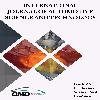Reducing of Pressure Based Drag Force of a Bus Model by Flow Control Rod in Wind Tunnel
The aerodynamic force of vehicles has been affected by the geometric shape of front surface. The aerodynamic force of a scaled bus model and CD were experimentally determined in wind tunnel. The experimental tests were conducted at 6 different free flow velocities. They were performed in the range of 3.8×103- 7.9×103 Reynolds number. The drawing data of model bus were obtained by 3D scanned and drawn in Solid Works program. The circular cross section flow control rod was designed in 10 mm, 20 mm and 30 mm diameter and positioned at 3 different locations (L/H) on the model bus. By this passive flow control method, aerodynamic drag reductions were obtained up to 10.06%, 7.35% and 7.85% respectively.
___
- 1- Cattafesta. L. N.. & Sheplak. M. (2011). Actuators for active flow control. Annual Review of Fluid Mechanics. 43(1). 247–272 . 2- Altaf A.. Omar. A.. & Asrar. W. (2014). Review of passive drag reduction techniques for bluff road vehicles. IIUM Engineering Journal. 15(1). 61-69.
- 3- Wood. R.M. and Bauer. S.X.S. (2003). Simple and low cost aerodynamic drag reduction devices for tractor-trailer Trucks. SAE Technical Paper. 01–3377. 1-18.
- 4- Cui. W. Zhu. H. Xia. C. Yanga. Z. (2015). Comparison of steady blowing and synthetic jets for aerodynamic drag reduction of a simplified vehicle. Procedia Engineering 126. 388 – 392.
- 5- Bayındırlı. C. Akansu. Y.E. Celik. M. (2020). Experimental And Numerical Studies On Improvement Of Drag Force Of A Bus Model Using Different Spoiler Models. Int. J. Heavy Vehicle Systems. 27-6. 743-776.
- 6- Hucho. W. H. & Sovran. G. (1993). Aerodynamics of road vehicles. Annual Review of Fluid Mechanics. 25(1). 485-537.
- 7- Mohamed-Kassim. Z. Filippone. A. (2010). Fuel savings on a heavy vehicle via aerodynamic drag reduction. Transportation Research Part D 15. 275–284.
- 8- Hassan S.M.R. Islam. T. Ali. M. Islam. Md. Q.(2014). Numerical Study on Aerodynamic Drag Reduction of Racing Cars. Procedia Engineering 90. 308 – 313.
- 9- Rohatgi. U.S. (2012). Methods of Reducing Vehicle Aerodynamic Drag. ASME 2012 Heat Transfer Conference Puesto Rico.USA.
- 10- Cui. W. Zhu. H. Xia. C. Yanga. Z (2015).” Comparison of steady blowing and synthetic jets for aerodynamic drag reduction of a simplified vehicle” Procedia Engineering 126. 388 – 392.
- 11- Jonathan. M. Erik. F. Gregory. R. Rajan. K. Kunihiko. T. Farrukh. A. Yoshihiro. Y. and Kei M. (2015).” Drag reduction on a flat-back ground vehicle with active flow control” Journal of Wind Engineering and Industrial Aerodynamics 145. 292–303.
- 12- Çengel. Y.A.. and Cimbala. J.M. (2008). Akışkanlar Mekaniği Temelleri ve Uygulamaları. Güven Bilimsel Yayınları. 562-599.
- 13- Özel. M. Aygün. E. Akansu. Y.E. Bayindirli. C. and Seyhan. M. (2015). The passive flow control around a truck-trailer model” International Journal of Automotive Engineering and Technologies 4 -4. 185 – 192.
- 14- Bayindirli. C. and Celik. M. (2018).”The experimentally and numerically determination of the drag coefficient of a bus model”. International Journal of Automotive Engineering and Technologies 7-3: 117-123.
- 15- Bansal, R., & Sharma, R. B. (2014). Drag reduction of passenger car using add-on devices. Journal of Aerodynamics, 2014, 1-13.
- 16- Bideaux, E., Bobillier, P., Fournier, E., Gilliéron, P., El Hajem, M., Champagne, J.Y., Gilotte, P., & Kourta, A. (2011). Drag reduction by pulsed jets on strongly unstructured wake: towards the square back control. International. Journal of Aerodynamics, 1(3/4), 282-298.
- 17- 32. Gillieron, P., & Kourta, A. (2013). Massive separation control analysis of the pulsed jet actuators effects, Mechanics & Industry, 14, 441–445.
- 18- Khalighi, B., Ho, J., Cooney, J., Neiswander, B., Corke, T., & Han, T. (2016). Aerodynamic Drag Reduction Investigation for a Simplified Road Vehicle Using Plasma Flow Control. Proceedings of the ASME 2016 Fluids Engineering Division Summer Meeting.
- 19- Tian, J., Zhang, Y., Zhu, H., & Xiao, H. (2017). Aerodynamic drag reduction and flow control of Ahmed body with flaps. Advances in Mechanical Engineering, 9(7), 1-17.
- 20- Bruneau, CH., Creusé, E., Depeyras, D., Gilliéron, P., & Mortazavi, I. (2010). Coupling active and passive techniques to control the flow past the square back Ahmed body. Computers & Fluids, 39 (2010), 1875–1892.
- 21- Mominul, IM., and Mohammad, ZA.(2019). Review on Aerodynamic Drag Reduction of Vehicles, International Journal of Engineering Materials and Manufacture, 4(1) 1-14.
- 22- Kandil, Y.B., Pehlivanoglu, O. and Y.V. (2012). Drag minimization using active and passive flow control technique, Aerospace Science and Technology, 17,21–31.
- 23- Sudin, M.N., Abdullah, M.A., Shamsuddin, S.A., Ramli, F.R. and Tahir, M.M. (2014). Review of research on aerodynamic drag reduction method, International Journal of Mechanical and Mechatronics Engineering IJMME-IJENS, 14-2, 35–45.
- 24- Mohamed, E.A. and Radhwi, M.N., Abdel Gawad, A.F. (2015). Computational investigation of aerodynamic characteristics and drag reduction of a bus model, American Journal of Aerospace Engineering, 2 (1-1), 64–73.
- Yayın Aralığı: Yılda 4 Sayı
- Başlangıç: 2016
- Yayıncı: Otomotiv Mühendisleri Derneği
Sayıdaki Diğer Makaleler
Berkay Karaçor, Mustafa Özcanlı
Taiwo S. Amosun, Olusegun D. Samuel
Yunus Emre Ekici, Teoman Karadağ, Mustafa Nurmuhammed, İsmail Can Dikmen
Kadir Sabancı, Kazım Çarman, Hanifi Küçüksarıyıldız
Hakan Serhad Soyhan, Mehrez Gassoumi, Fakher Hamdi, Zouhaier Boutar, Ridha Ennetta
